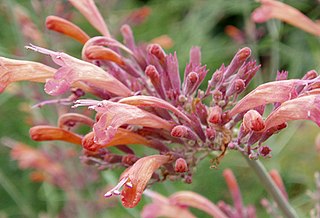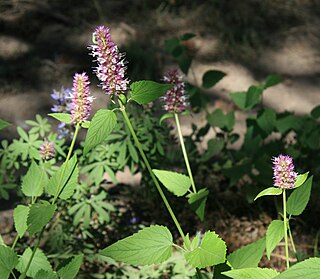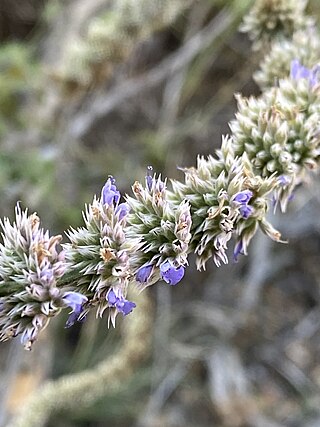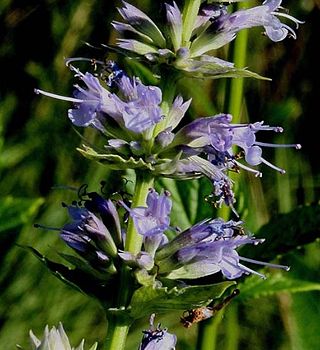
Hyssopus (hyssop) is a genus of herbaceous or semi-woody plants in the family Lamiaceae, native from the east Mediterranean to central Asia as far east as Mongolia. They are aromatic, with erect branched stems up to 60 cm long covered with fine hairs at the tips. The leaves are narrow oblong, 2–5 cm long. The small blue flowers are borne on the upper part of the branches during summer. By far the best-known species is the herb hyssop, widely cultivated outside its native area in the Mediterranean.

Agastache is a genus of aromatic flowering herbaceous perennial plants in the family Lamiaceae. It contains 22 species, mainly native to North America, one species native to eastern Asia. The common names of the species are a variety of fairly ambiguous and confusing "hyssops" and "mints"; as a whole the genus is known as giant hyssops or hummingbird mints.

Agastache rugosa, also known as wrinkled giant hyssop, Korean mint, purple giant hyssop, Indian mint and Chinese patchouli is an aromatic herb in the mint family, native to East Asia.
A blue giant is a hot star with a luminosity class of III (giant) or II.

Agastache rupestris, known as the threadleaf giant hyssop, Mexican Hyssop, or licorice mint, is a wildflower of the mint family (Lamiaceae) native to the mountains of Arizona, New Mexico, and Chihuahua, Mexico. Popular in xeriscaping because of its heat tolerance and ability to thrive in dry, nutrient-poor soil, it is often planted in containers or as a border flower and used to attract hummingbirds. Displaying gray-green stems and leaves while dormant, its orange flowers with purple buds bloom from mid-summer until fall; if crushed the petals exude a pleasant scent.
Agastache parvifolia is a species of flowering plant in the mint family known by the common name small-leaf giant hyssop. It is endemic to far northern California, where it grows in woodlands. It is an uncommon species and is sometimes considered a local subspecies of Agastache urticifolia.

Agastache urticifolia is a species of flowering plant in the mint family known by the common name nettleleaf giant hyssop or horse mint.

Agastache mexicana is a species of flowering plant in the mint family known by the common name Mexican giant hyssop. It is native to southern North America and can grow up to 100 cm tall. The leaves are lanceolate or oval-lanceolate. The plant is perennial and self-fertile. Its young lemon scented leaves are used in herbal teas and the leaves are also often used in flavoring foods.

Agastache foeniculum, commonly called anise hyssop, blue giant hyssop, Fragrant giant hyssop, or the lavender giant hyssop, is a species of perennial plant in the mint family, (Lamiaceae). This plant is native to much of north-central and northern North America. It is tolerant of deer and drought, and is visited by many pollinators.

Dalea candida is a species of flowering plant in the legume family known by the common name white prairie clover. It is native to North America, where it can be found throughout central Canada, the central United States, and northern Mexico. It can sometimes be found outside its range as an introduced species. It grows in many types of habitat, including several types of prairie, foothills, woods, forests, and disturbed areas.
Agastache cusickii is a species of flowering plant in the mint family known by the common name Cusick's giant hyssop. It is native to the northwestern United States from eastern Oregon and central Nevada to Idaho and Montana.
See also Zuni ethnobotany, and Native American ethnobotany.

Pleasant Valley Conservancy is a Wisconsin Department of Natural Resources-dedicated State Natural Area. The area contains a variety of natural communities found in Wisconsin including oak woodland, oak savanna, dry and wet prairies, sedge meadow, shrub-carr, and an open marsh.

Agastache wrightii is a plant species in the genus Agastache, family Lamiaceae. It is native to the US states of Arizona and New Mexico, as well as the Sierra Madre Occidental along the boundary between the Mexican states of Chihuahua and Sonora. Its common name is Sonoran giant hyssop.

Agastache scrophulariifolia, also known as the purple giant hyssop, is a perennial plant that grows throughout the US and northern Ontario, Canada. Its name comes from the similarity of its leaves to plants of the genus Scrophularia. It is a beneficial plant to pollinators and is noted for its medicinal properties, as many plants in the mint family are. It tends to grow in disturbed or open areas where it does not have to interact with non-native competitive plants.
Purple giant hyssop is a common name for several plants and may refer to:

Agastache nepetoides, commonly known as yellow giant hyssop, is a perennial flowering plant native to the central and eastern United States and Canada. It is a member of the Lamiaceae (mint) family.
Agastache occidentalis is a species of Agastache first described by Charles Vancouver Piper, and given its current name by Amos Arthur Heller. It is commonly known as western giant hyssop and giant horsemint.














